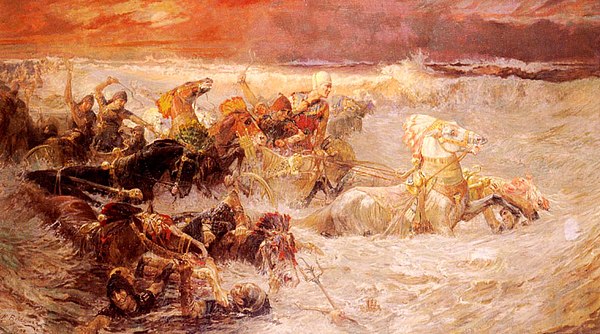 |
| Name this work of art |
Ten miracles were performed for our fathers in Egypt and ten at the [Red] Sea. Ten plagues did the Holy One, blessed be He, bring upon the Egyptians in Egypt and ten at the sea."
As we saw with the ten trials of Abraham, there is no agreement among the Rabbis as to what these ten Red Sea miracles actually were. Different lists have been produced by various interpreters. The first (?) and most famous one is in Avot d'Rabbi Natan. Here the performance of the miracles is imagined as a dialogue between Moshe and the people. After Moshe performs one miracle, the people demand another and refuse to cross until it is performed, and so on.
The ARN list includes the following miracles:
The ARN list includes the following miracles:
Tunnels were made in the sea
The sea was turned into a valley before them
Multiple paths (later, and not here, determined to be one for each tribe) were opened up in the sea
The water (or the path) was turned into clay
The water (or the path) was dry (or as barren) as a desert or wilderness
The sea was broken into pieces (I do not know what this means)
The sea was turned into rocks (as paving stones?)
The sea was turned into dry land (I don't see how this is different from a valley or a wilderness)
The sea was turned into walls (I don't see what advantage this offers)
The sea stood up like Nayd Nozlim (flasks containing liquids?) which released honey and oil into the mouths of children
And (11th miracle) some say that fresh water came out of the sea for them.
Cleverly, the author (or, OK, let's be fancy, the tradents) connects each of these miracles to an interpretation of a verse. Interestingly enough, he's willing to suggest 11 miracles, though his text speaks specifically of 10.
To me this suggests two things occurred - perhaps concurrently. Over time, interpreters working in various eras interpreted various verses in ways that suggested extra miracles occurred at the Red Sea. For instance Psalm 136:13 tells us the Sea was divided into sections (KJV: divided the Red sea into parts ). Why, an interpreter may have asked, was this necessary? The apparent answer: To (miraculously) allow each Tribe to have its own private path.
Simultaneously, or perhaps afterwards, it was somehow and for some reason decided that exactly ten miracles were performed for the Jews at the sea. I don't know where we got this idea, but I have some guesses: Perhaps someone counted up the verse interpretations mentioned above and came up with ten miracles; or, more likely, perhaps someone noticed that the Song of the Sea mentions 10 bad things that happened to the Egyptians at the sea (they were sunk in the water; dashed to pieces; sunk like lead, etc) and thought it was appropriate to match those ten negatives with ten miracles.
When I first started investigating this question, I expected to find that the ten Red Sea Miracles were examples of what I irreverently call "Midrashic fan fiction." In many places we find the Rabbis describing miracles or personalities or events in hyperbolic terms. For example, we're told Pharaoh was a midget, presumably as a way of embarrassing him. The Rabbis often did this to make their points, or opinions or editorial viewpoints abundantly clear. I had assumed that the Red Sea miracles were also an example of this. I thought the stories about paved roads and honey dispensers were invented simply to emphasize God's goodness to us.
Now I think there's probably more to the story.
Search for more information about Red Sea Miracles at4torah.com
To me this suggests two things occurred - perhaps concurrently. Over time, interpreters working in various eras interpreted various verses in ways that suggested extra miracles occurred at the Red Sea. For instance Psalm 136:13 tells us the Sea was divided into sections (KJV: divided the Red sea into parts ). Why, an interpreter may have asked, was this necessary? The apparent answer: To (miraculously) allow each Tribe to have its own private path.
Simultaneously, or perhaps afterwards, it was somehow and for some reason decided that exactly ten miracles were performed for the Jews at the sea. I don't know where we got this idea, but I have some guesses: Perhaps someone counted up the verse interpretations mentioned above and came up with ten miracles; or, more likely, perhaps someone noticed that the Song of the Sea mentions 10 bad things that happened to the Egyptians at the sea (they were sunk in the water; dashed to pieces; sunk like lead, etc) and thought it was appropriate to match those ten negatives with ten miracles.
 |
| Sus v'rochvo rama bayam |
Now I think there's probably more to the story.
Search for more information about Red Sea Miracles at4torah.com